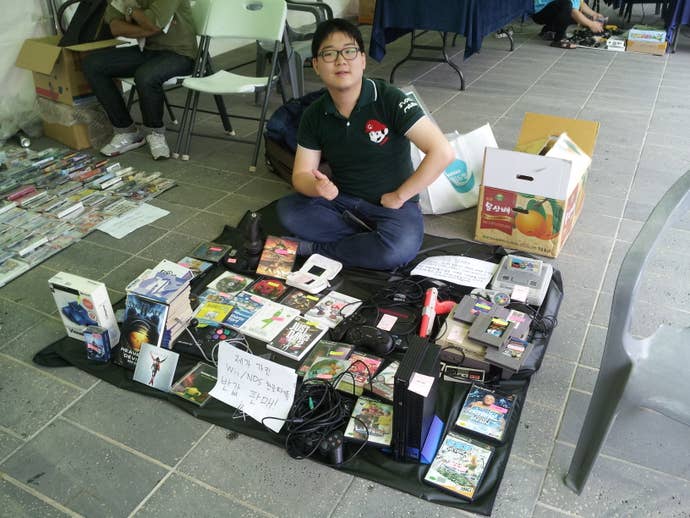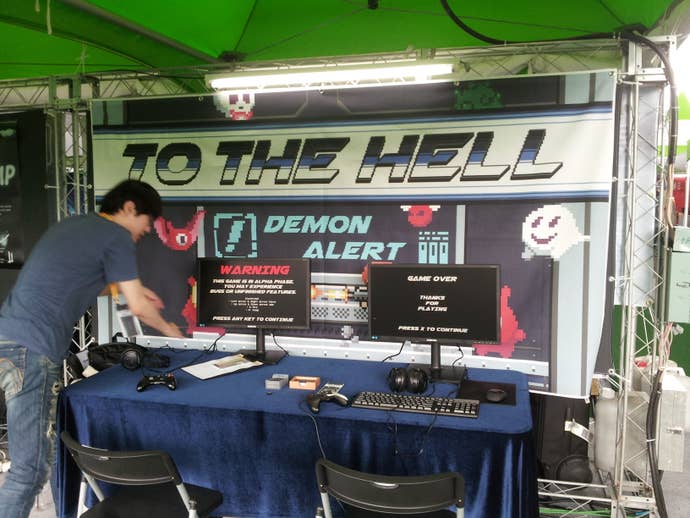Three Days in Busan, Day 1: Connecting With Indies in Korea at BIC Fest
While Japan prepped for TGS, the South Korean industry recently held an event of their own. Here's what contributor Daniel Feit found when he went to Busan Indie Connect Festival 2016.
This article first appeared on USgamer, a partner publication of VG247. Some content, such as this article, has been migrated to VG247 for posterity after USgamer's closure - but it has not been edited or further vetted by the VG247 team.
Disclosure: Accommodations in Busan were paid for by the BIC Fest organizers.
The Busan Indie Connect Festival began last year, drawing inspiration from BitSummit in neighboring Japan, as a means to draw the public’s attention to the efforts of independent Korean game developers and to foster connectivity between the Japanese and Korean indie scenes. The show was a success, so much so that a BIC Festival booth was present at BitSummit this summer. Two months later, I am here in Busan again to see this year’s sophomore outing. BICFest 2016 is even larger than the first, having expanded to three days and relocated to the open-air plaza of the Busan Cinema Center.

Despite the new outdoor locale the first day began inside an auditorium at 9am with an entire morning of presentations for developers. While there were plenty of sales pitches for store fronts and publishing platforms, there were also indie success stories on hand to tell tales of how they found an audience for their pet projects. The biggest name in the room was Tarn Adams, co-creator of Dwarf Fortress, who was on-hand to discuss his inspirations, his early creations, and his life over the last ten years managing his lo-fi indie hit.
I must admit that all I knew of Dwarf Fortress prior to Adams’ presentation was jovial comments concerning the game on podcasts whenever anyone dared to compare it to any other game. Based on what I know now, I’m not sure anything else in any medium compares. What Dwarf Fortress lacks in graphics - the entire game is text-based using colors and symbols to “draw” the world map - it makes up for it in depth with a unique world generated for every player, complete with a history of empires and invasions. It began as just another side-project though, a sequel to a game with 3D graphics that wasn’t quite working. Dwarf Fortress became an amalgam of ideas Tarn Adams and his brother Zach had for other games, and the simple visuals meant it all worked without any need for toiling with complex graphics.

Tarn revealed that serendipity made Dwarf Fortress his primary job for the last decade. He just happened to leave his day job when it was first released in 2006 and as a community formed, grateful players began contacting him with offers of money for the free game. The Adams brothers stumbled into a Patreon-style revenue model before there was Patreon: monthly fan donations became more than enough to support the two of them.
After a lunch break gave us all a chance to visit the food trucks parked outside the exhibition space, it was time to see some games. This first day of BICFest was only open to exhibitors and invitees, so the developers took turns in groups playing games and showing their games to others. All the booths were outside under tents beneath the massive roof of the Busan Cinema Center, a welcome change from last year’s show which had developers standing in hallways lined with tables. That said, the outdoor locale made it easy for random pedestrians and even children to wander between tables. Even though this first day was not meant for the general public, I don’t think there were stringent checks at the gate given that BICFest does not charge an admission fee.

Quick takes on the games that caught my eye on Day 1:
- Detention is a historical horror game out of Taiwan, a point-and-click adventure set during that nation’s tumultuous 1950s. The lead character is a high school student who wakes up in an empty school during a typhoon. It’s a gray, spooky game even before any ghosts show up, as the cloud of government oppression and censorship hang over the school just as much as actual rainclouds. Red Candle Games’ Light Wang, the level designer of Detention, told me that the team used their own nation’s history as well as Taoist and Buddhist elements to make their horror game unlike anything out of Japan or the West. The game should be available on Steam next January.
- Sally’s Law is a cute puzzle platformer that, at first glance, contain no puzzles. Nanali Studios’ CEO Minjae Bak told me that “Sally’s Law” is the “opposite of Murphy’s Law” in that everything goes right for Sally, no matter what. Playing the game reveals the truth of the matter: you control Sally first, then you replay each stage as her father struggling behind the scenes to make sure she breezes past every obstacle. Did I mention that both Sally and her father are adorable rotund beings who roll rather than walk? It’s a cute concept and even cuter to look at. Bak told me Sally’s Law will launch this month on mobile as well as PC.
- I. F. O. (as in Identified Flying Object) is a shooter where your aircraft takes on wave after wave of alien vessels. It’s made to look like a throwback to the Game & Watch or Tiger Electronics era of handheld LCD games, and even beeps like a digital alarm clock when your vessel is in danger. Shooting down flying saucers is the primary goal, but collecting the alien pilots as they fall is where the high scores and power-ups come into play. The faster you take prisoners, the stronger your fighter becomes, though the enemies likewise strengthen the longer you play. While it’s a high-score challenge for now, creator Gon Lee says he’s unsure whether the final game will have an ending or not. I. F. O. is currently in development for smartphones and tablets with a potential PC port to follow.
- To The Hell, perhaps my favorite game name of the show, bears a superficial similarity to Super Crate Box. Both are shooters with swarms of enemies and replacement weapons which arrive in unmarked crates, but that’s all the two games share. To The Hell is more like a traditional run-and-gun shooter in that it has sequential stages, boss battles, hit points, and the occasional power-up presented by the Grim Reaper himself. There’s also periodic, seemingly random handicaps like sticky floors or falling rocks to increase the challenge. It definitely has an ending, or at least it will once creator Jaewon Yoo finishes it. He hopes to have it on PCs by the end of this year, though he admits it’s a side-project that he’s tackling alone.
- Megacopter: Blades of the Goddess (my second-favorite game name of the show) is an isometric shooter starring a sentient, homicidal helicopter from the Aztec empire. I could explain about the reptile men or the pilot’s misgivings about war but instead let me repeat: Megacopter: Blades of the Goddess stars a sentient, homicidal helicopter from the Aztec empire. “It’s kind of a Knight Rider/KITT-kind of relationship,” artist Gabe Miller told me, “except the Megacopter is bloodthirsty and evil.” Miller lives in Seoul and has spent two years working on the game as a side-project with a programmer back in his hometown of Oklahoma City, so he couldn’t say when the game might be ready for PCs.
- aVoid is a simple puzzle game about “a Void robot” that can pass through (or avoid, get it?) solid objects. Each level requires careful timing: players tap the screen to fall through the floor or walls but hold too long and the robot will fall off screen into nothingness. It’s the product of a most unusual team: three of the four people making aVoid are just teenagers, but the fourth is an adult in her thirties. After the three youths spent years making games together, they reached out online to find a graphic designer in Seoul to join their team. They hope to release aVoid on mobile storefronts early next year.
- Speaking of teenagers, I was astonished to learn the creator of Sacred Stones is just eighteen. Illjoung Kim said that he was inspired by Cave Story when making Sacred Stones and the homage is obvious. It’s a dead ringer for the indie classic, although its structure is more of a boss rush than a Metroidvania. It’s also wicked tough as your character dies after a single hit. Kim said he completed Sacred Stones by himself in just six months and expects to publish it on PC and mobile before the end of September. While it’s his biggest work to date, he says he’s already started making his next game which he says is even bigger. Definitely one to watch for.

When the sun set on day one of BICFest the booths shut down in favor of a party for all invitees to celebrate the festival’s second year. There were a lot of congratulatory speeches, sponsors honored the titles they liked best (a separate slate of awards will be named at the end of the show), plus live music and a big-screen tournament of Arena Gods, an indie multiplayer brawler that had the entire party roaring over every kill.
The finale of this long first day was a full screening of Branching Paths, the documentary on the Japanese indie game scene shot over two years and recently released digitally on Steam and Playism. Without focusing on a single creator or team, the film instead covers the slow but steady growth of Japanese indie games thanks to an increase of public events like BitSummit and the new (in 2013) indie area at Tokyo Game Show. While none of the subjects were Korean, many of them were present at BICFest this year (or last) and the film’s story depicting the rise of an underappreciated independent gaming and creative scene must have hit home for the spectators.
By the time the movie wrapped it was 10:30 at night and thirteen hours of video games is more than enough for me in a single day. With BICFest being three days long this year, expect two more daily journals of my experiences in Busan. More games and the arrival of the public await.
